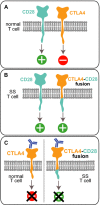Personalized treatment of Sézary syndrome by targeting a novel CTLA4:CD28 fusion
- PMID: 25802883
- PMCID: PMC4367085
- DOI: 10.1002/mgg3.121
Personalized treatment of Sézary syndrome by targeting a novel CTLA4:CD28 fusion
Abstract
Matching molecularly targeted therapies with cancer subtype-specific gene mutations is revolutionizing oncology care. However, for rare cancers this approach is problematic due to the often poor understanding of the disease's natural history and phenotypic heterogeneity, making treatment of these cancers a particularly unmet medical need in clinical oncology. Advanced Sézary syndrome (SS), an aggressive, exceedingly rare variant of cutaneous T-cell lymphoma (CTCL) is a prototypical example of a rare cancer. Through whole genome and RNA sequencing (RNA-seq) of a SS patient's tumor we discovered a highly expressed gene fusion between CTLA4 (cytotoxic T lymphocyte antigen 4) and CD28 (cluster of differentiation 28), predicting a novel stimulatory molecule on the surface of tumor T cells. Treatment with the CTLA4 inhibitor ipilimumab resulted in a rapid clinical response. Our findings suggest a novel driver mechanism for SS, and cancer in general, and exemplify an emerging model of cancer treatment using exploratory genomic analysis to identify a personally targeted treatment option when conventional therapies are exhausted.
Keywords: CD28; CTLA4; Sézary syndrome.
Figures



References
-
- Bentley DR, Balasubramanian S, Swerdlow HP, Smith GP, Milton J, Brown CG, et al. Accurate whole human genome sequencing using reversible terminator chemistry. Nature. 2008;456:53–59. doi: 10.1038/nature07517. - DOI - PMC - PubMed
-
- Craig DW, O'Shaughnessy JA, Kiefer JA, Aldrich J, Sinari S, Sinari S, et al. Genome and transcriptome sequencing in prospective metastatic triple-negative breast cancer uncovers therapeutic vulnerabilities. Mol. Cancer Ther. 2013;12:104–116. doi: 110.1158/1535-7163.MCT-1112-0781. - PubMed
-
- Dennehy KM, Elias F, Zeder-Lutz G, Ding X, Altschuh D, Luhder F, et al. Cutting edge: monovalency of CD28 maintains the antigen dependence of T cell costimulatory responses. J. Immunol. 2006;176:5725–5729. - PubMed
-
- Hoff H, Kolar P, Ambach A, Radbruch A. Brunner-Weinzierl MC. CTLA-4 (CD152) inhibits T cell function by activating the ubiquitin ligase Itch. Mol. Immunol. 2010;47:1875–1881. doi: 10.1016/j.molimm.2010.03.017. - DOI - PubMed
LinkOut - more resources
Full Text Sources
Other Literature Sources

